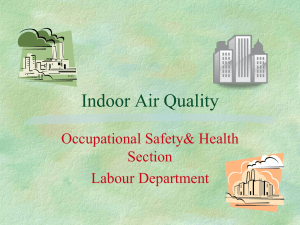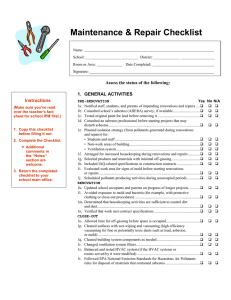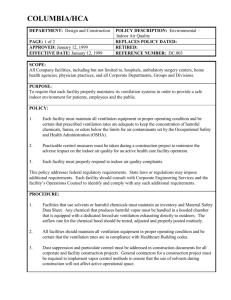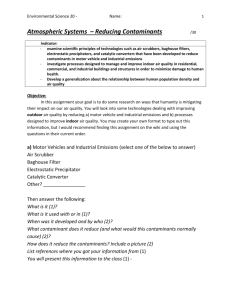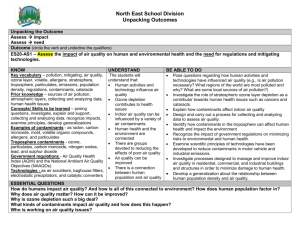Maintaining Indoor Air Quality During Construction and Renovation Projects I. Introduction
advertisement
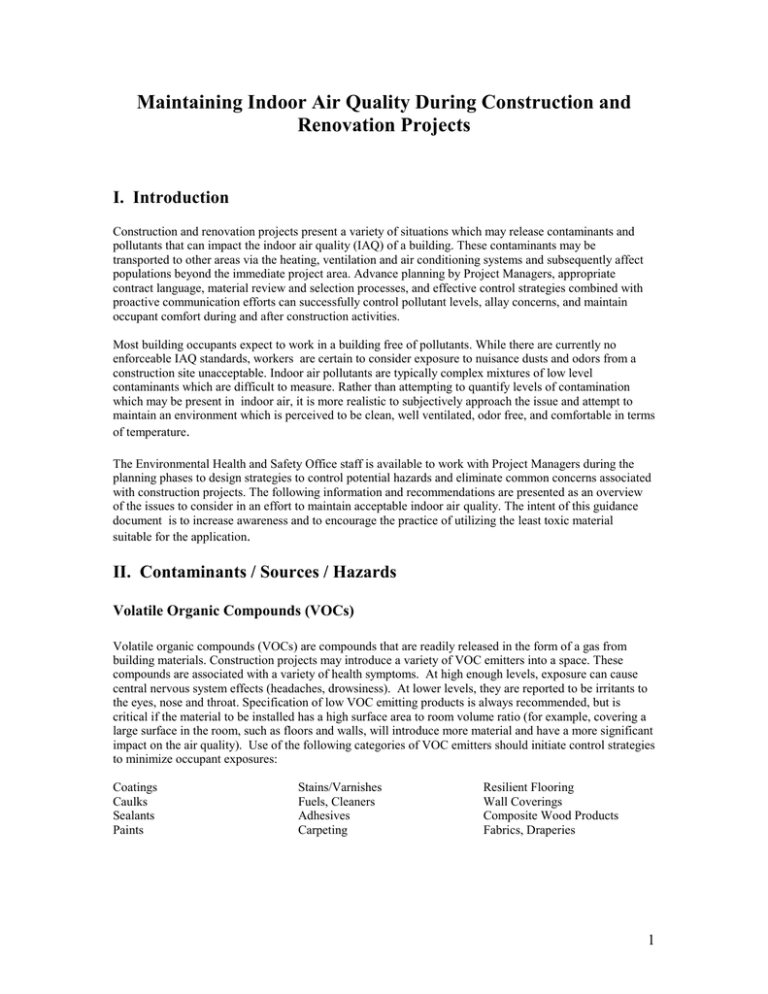
Maintaining Indoor Air Quality During Construction and Renovation Projects I. Introduction Construction and renovation projects present a variety of situations which may release contaminants and pollutants that can impact the indoor air quality (IAQ) of a building. These contaminants may be transported to other areas via the heating, ventilation and air conditioning systems and subsequently affect populations beyond the immediate project area. Advance planning by Project Managers, appropriate contract language, material review and selection processes, and effective control strategies combined with proactive communication efforts can successfully control pollutant levels, allay concerns, and maintain occupant comfort during and after construction activities. Most building occupants expect to work in a building free of pollutants. While there are currently no enforceable IAQ standards, workers are certain to consider exposure to nuisance dusts and odors from a construction site unacceptable. Indoor air pollutants are typically complex mixtures of low level contaminants which are difficult to measure. Rather than attempting to quantify levels of contamination which may be present in indoor air, it is more realistic to subjectively approach the issue and attempt to maintain an environment which is perceived to be clean, well ventilated, odor free, and comfortable in terms of temperature. The Environmental Health and Safety Office staff is available to work with Project Managers during the planning phases to design strategies to control potential hazards and eliminate common concerns associated with construction projects. The following information and recommendations are presented as an overview of the issues to consider in an effort to maintain acceptable indoor air quality. The intent of this guidance document is to increase awareness and to encourage the practice of utilizing the least toxic material suitable for the application. II. Contaminants / Sources / Hazards Volatile Organic Compounds (VOCs) Volatile organic compounds (VOCs) are compounds that are readily released in the form of a gas from building materials. Construction projects may introduce a variety of VOC emitters into a space. These compounds are associated with a variety of health symptoms. At high enough levels, exposure can cause central nervous system effects (headaches, drowsiness). At lower levels, they are reported to be irritants to the eyes, nose and throat. Specification of low VOC emitting products is always recommended, but is critical if the material to be installed has a high surface area to room volume ratio (for example, covering a large surface in the room, such as floors and walls, will introduce more material and have a more significant impact on the air quality). Use of the following categories of VOC emitters should initiate control strategies to minimize occupant exposures: Coatings Caulks Sealants Paints Stains/Varnishes Fuels, Cleaners Adhesives Carpeting Resilient Flooring Wall Coverings Composite Wood Products Fabrics, Draperies 1 Particulates (Dusts and Fibers) Nuisance Construction activities may also introduce particulate matter such as dusts and fibers into an environment. Non toxic or nuisance dusts will be created by cutting, sanding, disturbing dirty areas or the installation of Portland cement, gypsum, limestone, and Plaster of Paris. These dusts will cause no long term health effects, but can increase occupant discomfort and can be mistaken for more hazardous materials such as asbestos. Fiberglas and mineral wool can be irritating to the skin, eyes, and respiratory tract. While long term health effects are still being studied, environmental controls and appropriate personal protective equipment should be implemented. Hazardous Particulates which are subject to special regulation include lead paint dust which is toxic to the nervous system, and asbestos which is a carcinogen. Projects which may disturb lead painted surfaces or asbestos containing materials warrant close supervision to ensure compliance with all applicable laws. Consult the EH&S Office to determine if a building survey has been completed. Licensed and certified contractors will be required to conduct these types of activities. Combustion Products Combustion sources ( vehicles, generators, and space heaters) may introduce carbon monoxide, carbon dioxide, nitrogen oxides, and sulfur dioxide into a space. Welding can produce these contaminants as well as ozone. These gases may cause eye, nose, throat, and respiratory system irritation. Some individuals, such as those with asthma, may experience more serious reactions. Carbon monoxide exposure may cause headache, dizziness, rapid heartbeat, and at high levels can be fatal. Biological Materials Demolition of materials and disturbance of previously sealed areas may contribute to the release of biological pollutants. Fungi, dust mites, insect parts, and microorganisms can become airborne when renovations are undertaken, stagnant water is encountered, and bird or animal droppings are disturbed. Chronically wet or damp areas may be reservoirs of gross contamination. Exposed individuals may develop allergic reactions or infections. Engineering controls to minimize worker and occupant exposure, personal protective equipment, and proper decontamination techniques must be considered when biological contamination may be present. Physical Agents Lastly, physical agents such as noise, vibration, and uncomfortable temperatures can generate complaints from building occupants working adjacent to a renovation. Construction activities may interrupt heating, ventilating, and air conditioning services. Vibration can also contribute to more serious hazards such as the delamination of asbestos material in another space, or the creation of a chemical spill when containers fall from shelves. 2 III. IAQ Control Strategies Early identification of existing building hazards is the first step toward eliminating the development of an IAQ problem. Inspect the area to be renovated during the project planning stage. Look for possible asbestos and lead containing materials which may be disturbed. Attempt to identify sources of dust and microbial contamination. Consult EH&S documentation and arrange for surveys and analyses when appropriate. Implement a strategy of source management by choosing one or more of the following: Source Removal Identify a source of contamination and relocate it so that it will not impact the IAQ. For example, do not locate a diesel generator or a roofing kettle near a building air intake. Source Substitution Identify a material likely to impact the IAQ and select a similar but less toxic substitute. Review MSDS’s, manufacturer specifications, and consult with EH&S. For example, choose latex over oil based paint, hardwood over pressed wood, water based over solvent based adhesives, low formaldehyde emitting fabrics, and continuous filament carpet. Consult Boston College Standards for materials which have been reviewed and determined to be acceptable. Source Encapsulation Create a barrier around the source and isolate it from other areas of the building so that there is no recirculation of air from the work area into occupied spaces. This may include physically isolating a section of the building with polyethylene sheeting or other barriers, as well as isolating the space from the general ventilation system by blocking return air grilles. Keep doors closed and seal stairwells so that they do not act as conduits for contaminants. Ventilation Utilize either dilution ventilation or local exhaust ventilation in conjunction with isolation techniques to reduce contaminant levels. Dilution ventilation increases the amount of outside air passing through an area to dilute and flush out low levels of contaminants. If the building ventilation system will be in contact with the work area, consider installing additional filters to keep particulates out of the ductwork. Change all filters at the conclusion of the project. When strong odors and higher contaminant levels are expected, the area should be encapsulated and placed under negative pressure. This technique isolates the work area from the building ventilation system and uses exhaust fans to directly remove contaminants to the outside. Explosion proof fans must be used while there are flammable chemicals being used in the work area. Positively pressurizing non-work areas and running ventilation systems overnight will minimize contaminant migration into occupied spaces. 3 Exposure Control It may be unrealistic to attempt to completely eliminate airborne contaminants during a construction project, but it is possible to minimize occupant exposure to those contaminants by carefully scheduling the work during periods of low occupancy such as holidays, evenings and weekends. In addition, allow for a “flush out” period of ventilation prior to reoccupying the work area. It is recommended that the area be flushed out with maximum outside air at normal temperatures for 72 hours prior to reoccupancy. Increased ventilation may also be warranted for 2 weeks to 2 months post occupancy to remove low level off gassing. Finally, be sensitive to the fact that some individuals are more susceptible to low level contaminants than most, and these people may need to be temporarily relocated. Health Services and occupational health specialists may need to be involved in these determinations. Housekeeping Good housekeeping practices will go a long way toward containing dusts and construction debris, and allowing building occupants to feel confident that the project is well managed. Consider using a HEPA filtered vacuum cleaner to minimize recirculation of contaminants. Suppress dust with wet methods. Quickly clean up spilled materials. Protect porous materials such as insulation from exposure to moisture and contaminants. IV. Notification / Communication Proactive communication and advance notification of all affected parties can prevent IAQ issues from developing and escalating. Develop a list of building or departmental contacts who can disseminate project details and schedules to all building occupants. Classroom work should include notification of the Registrar’s Office. Signage might be posted to provide a phone number for concerned visitors seeking information. Request that building occupants first contact these representatives, who will then communicate concerns to the Project Manager for resolution. Provide accurate information about chemical products which will be used, noises, dusts, odors, and disruptions to the normal routine well in advance of the project start date. Explain that the least toxic materials available have been selected, and provide Material Safety Data Sheets for review. Listen to occupant concerns, discuss control strategies which will be implemented to minimize contaminants, and allow the end user to have input into the scheduling process. Make allowances for individuals with special concerns or sensitivities. Keep actual health risks in proper perspective. Temporary relocation and referral to Health Services may occasionally be warranted. V. Example Projects Flooring During flooring operations, existing building materials ( sheet & tile flooring and mastic) which must be removed or prepared must first be examined to see if they are asbestos containing materials (ACM). Consult EH&S or the building survey for this information. Grinding, surfacing, sanding, abrading, breaking or removing ACM flooring may only be done by a licensed asbestos contractor according to all pertinent regulations. 4 Review the manufacturers specifications on replacement carpet and vinyl flooring and select those with low emission data. New products which are opened and unrolled at the contractors’ facility will emit fewer VOCs upon installation. More importantly, consult the approved products listing and select a low emitting adhesive for flooring installation. Always follow the manufacturers recommendations for use and ventilation. Maintain a copy of the MSDS on site. Minimize the amount of chemical product stored at the construction site, and ensure that containers not in use are kept sealed. Select the most appropriate flooring material for the space. Carpeting used in areas subject to moisture will promote microbial growth contributing to IAQ problems in the future. Implement some combination of the source management techniques to control contaminant levels generated during and after construction. Painting Painting operations should begin with the confirmation that the painted surface to be prepared is lead free. Consult EH&S and building surveys for this information. Sanding of lead paint is prohibited and removal may only be done by a licensed deleading contractor according to all pertinent regulations. Select a low VOC emitting paint that is free of lead and mercury. Minimize occupant exposure to interior painting by scheduling it during off hours, isolating the space, and ventilating the area well both during and after the painting is completed. Refer to the source management techniques referred to previously. Roofing Outdoor work, such as roofing, can also have a significant impact on indoor air quality. Hot tar and hot asphalt materials are intensely odorous, and will generate many complaints if the emissions are drawn into the building. Locate these sources away from air intakes when feasible, and consider wind patterns. Instruct occupants to keep doors and windows closed. Indoor air intakes may need to be temporarily shut down. Whenever possible, schedule this work during low occupancy periods and provide good communication to all impacted parties which may include neighboring buildings. Roofing materials may also contain asbestos. Consult EH&S and the building survey to ensure that all pertinent regulations are being implemented when handling asbestos containing materials. 7/98 Boston College Office of Environmental Health and Safety 5

